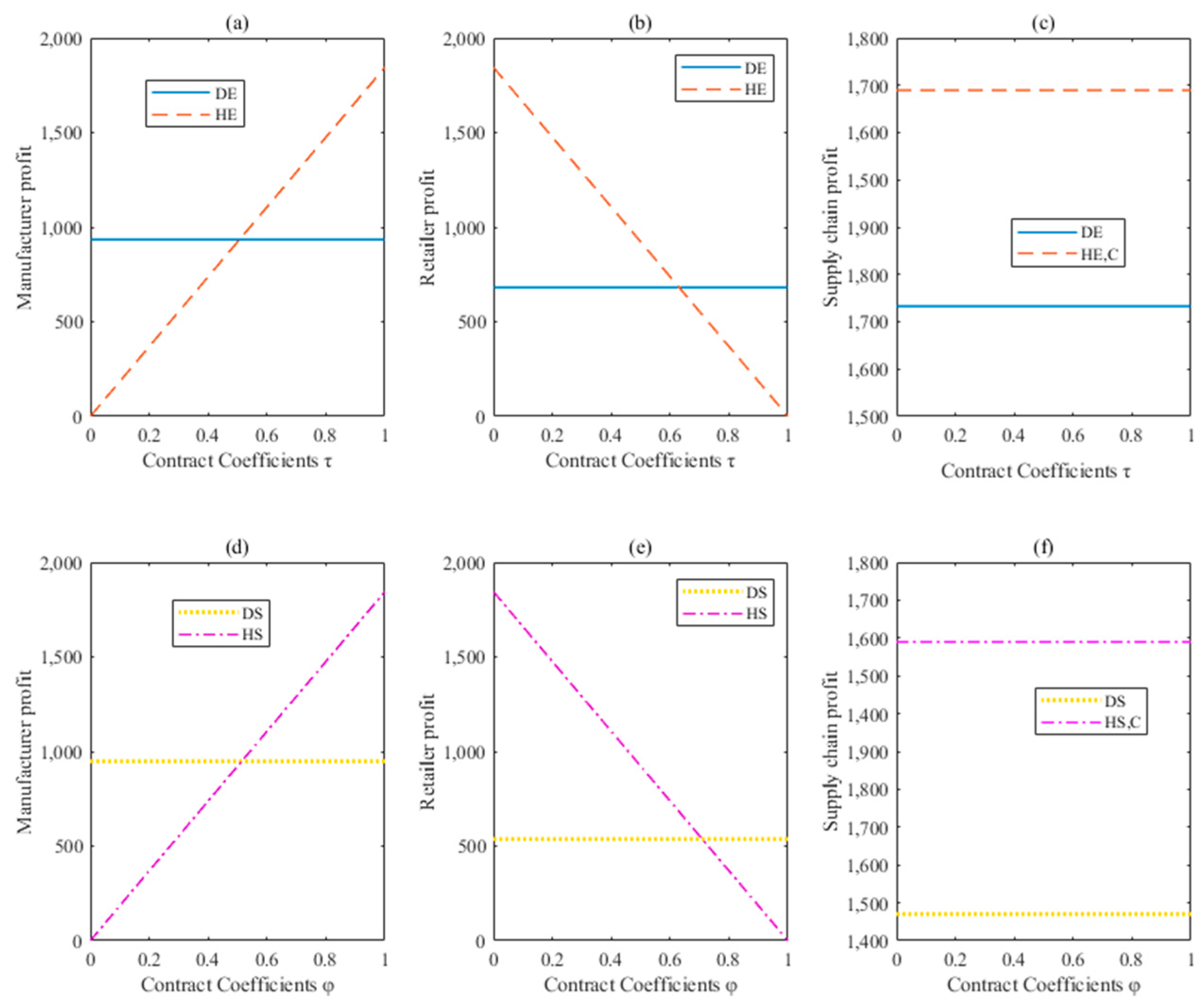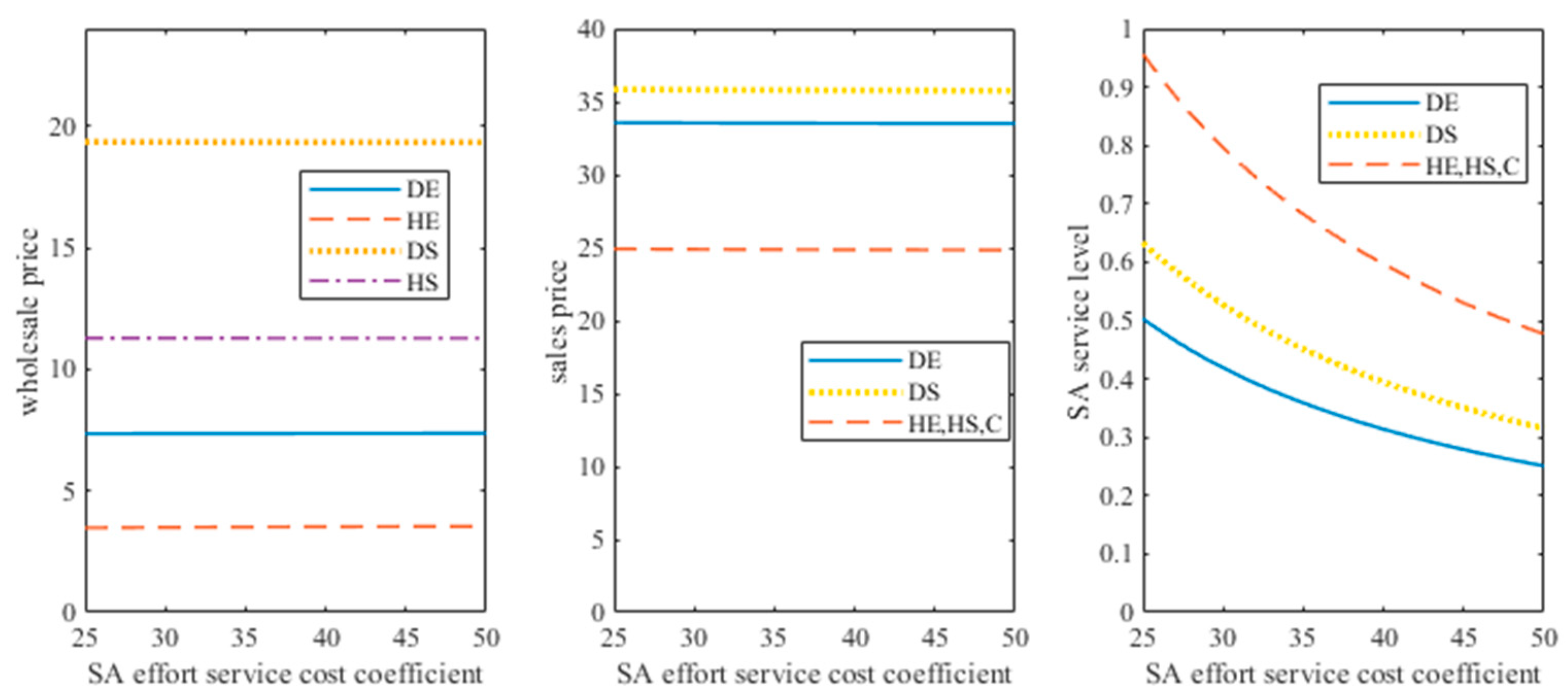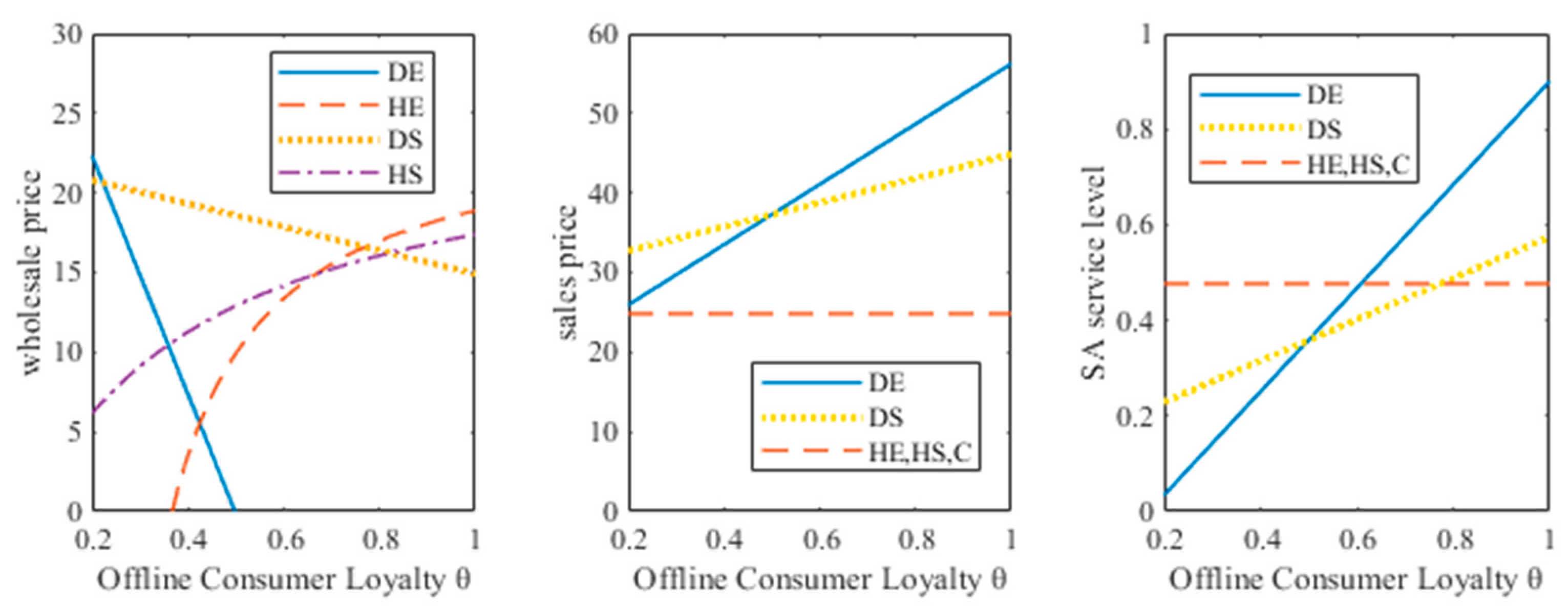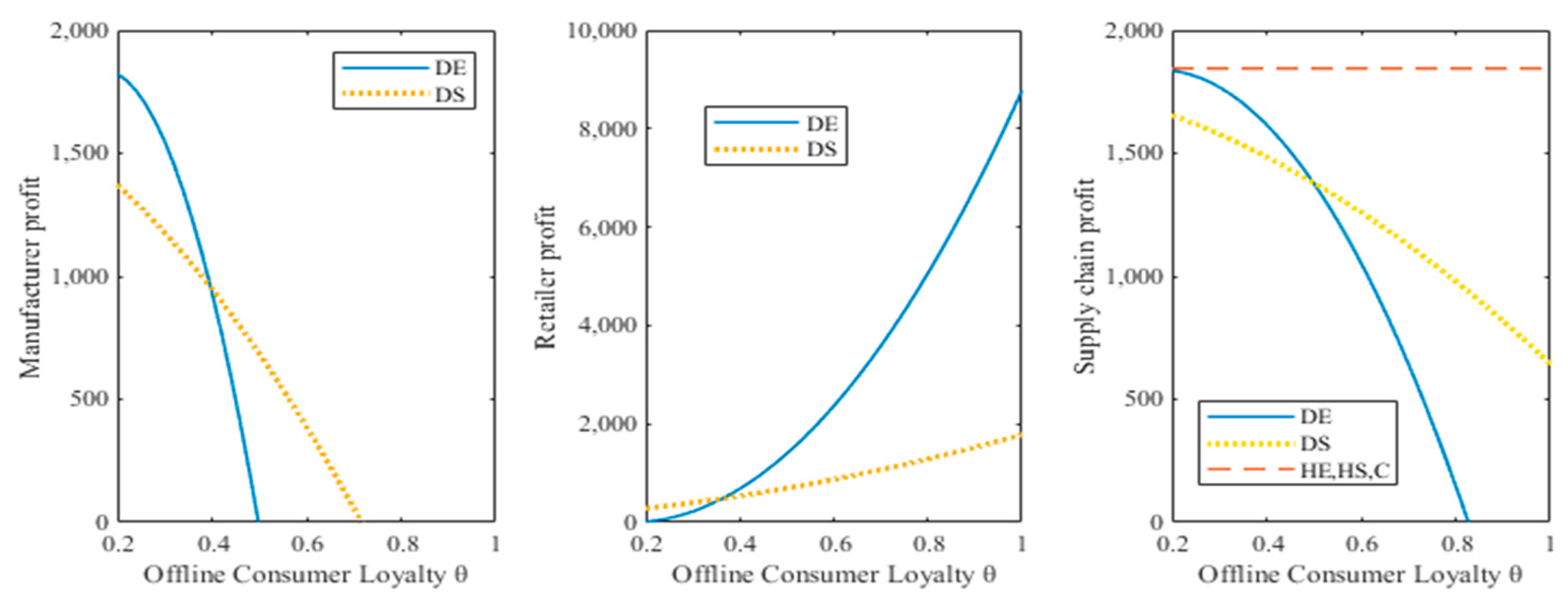Pricing and Contract Coordination of BOPS Supply Chain Considering Product Return Risk
Abstract
:1. Introduction
2. Literature Review
2.1. Management of Channels
2.2. Product Return Risks
3. Problem Statement
4. Model Formulation and Analysis
4.1. Centralized Decision
4.2. Decentralized Decision
4.2.1. BOPS Channel Managed by the Manufacturer
4.2.2. BOPS Channel Managed by the Retailer
5. The BOPS Omni-Channel Supply Chain Coordination and Optimization Research
5.1. BOPS Channel Managed by the Manufacturer
5.2. BOPS Channel Managed by the Retailer
6. Numerical Analysis
6.1. Optimal Decision and Profit Comparative Analysis
6.2. Sensitivity Analysis of Contract Coefficients τ and φ
6.3. Sensitivity Analysis of SA Effort Service Level Cost Coefficient
6.4. Sensitivity Analysis of Offline Consumer Loyalty θ
7. Discussion and Conclusions
7.1. Conclusions
7.2. Theoretical Implications
7.3. Practical Implications
7.4. Limitation and Future Research
Author Contributions
Funding
Institutional Review Board Statement
Informed Consent Statement
Data Availability Statement
Conflicts of Interest
References
- Zhang, J.Z.; Xu, Q.Y.; He, Y. Omnichannel retail operations with consumer returns and order cancellation. Transp. Res. Part E Logist. Transp. Rev. 2018, 118, 308–324. [Google Scholar] [CrossRef]
- Brynjolfsson, E.; Hu, Y.J.; Rahman, M.S. Competing in the Age of Omnichannel Retailing. MIT Sloan Manag. Rev. 2013, 54, 23–29. [Google Scholar]
- Patel, C. Successful service retail channel expansions: The roles of technical and brand integration. Ind. Market Manag. 2014, 43, 102–112. [Google Scholar] [CrossRef]
- Bell, D.R.; Gallia, S.; Moreno, A. How to Win in an Omnichannel World. MIT Sloan Manag. Rev. 2014, 56, 45–53. [Google Scholar]
- Verhoef, P.C.; Kannan, P.K.; Inman, J.J. From Multi-Channel Retailing to Omni-Channel Retailing Introduction to the Special Issue on Multi-Channel Retailing. J. Retail. 2015, 91, 174–181. [Google Scholar] [CrossRef]
- Zheng, Q.; Wang, M.; Yang, F. Optimal Channel Strategy for a Fresh Produce E-Commerce Supply Chain. Sustainability 2021, 13, 6057. [Google Scholar] [CrossRef]
- Kim, Y. Revitalization of Offline Fashion Stores: Exploring Strategies to Improve the Smart Retailing Experience by Applying Mobile Technology. Sustainability 2021, 13, 3434. [Google Scholar] [CrossRef]
- Kim, K.-H.; Han, S.-L.; Jang, Y.-Y.; Shin, Y.-C. The Effects of the Antecedents of “Buy-Online-Pick-Up-in-Store” Service on Consumer’s BOPIS Choice Behaviour. Sustainaility 2020, 12, 9989. [Google Scholar] [CrossRef]
- Gao, F.; Su, X.M. Omnichannel Retail Operations with Buy-Online-and-Pick-up-in-Store. Manag. Sci. 2017, 63, 2478–2492. [Google Scholar] [CrossRef] [Green Version]
- He, Y.; Xu, Q.Q.; Zhao, D. Impacts of the BOPS Option on Sustainable Retailing. Sustainability 2020, 12, 8600. [Google Scholar] [CrossRef]
- Liu, J.; Xu, Q. Joint decision on pricing and ordering for omnichannel bops retailers: Considering online returns. Sustainability 2020, 12, 1539. [Google Scholar] [CrossRef] [Green Version]
- Ramani, S.V.; SadreGhazi, S.; Duysters, G. On the diffusion of toilets as bottom of the pyramid innovation: Lessons from sanitation entrepreneurs. Technol. Forecast. Soc. Chang. 2012, 79, 676–687. [Google Scholar] [CrossRef]
- Chowdhury, M.M.H.; Quaddus, M.A. Supply chain sustainability practices and governance for mitigating sustainability risk and improving market performance: A dynamic capability perspective. J. Clean. Prod. 2021, 278, 123521. [Google Scholar] [CrossRef]
- Chen, J.; Chen, B.T. Competing with customer returns policies. Int. J. Prod. Res. 2016, 54, 2093–2107. [Google Scholar] [CrossRef]
- Zhou, Y.W.; Guo, J.S.; Zhou, W.H. Pricing/service strategies for a dual-channel supply chain with free riding and service-cost sharing. Int. J. Prod. Econ. 2018, 196, 198–210. [Google Scholar] [CrossRef]
- Xu, S.; Tang, H.; Lin, Z. Inventory and Ordering Decisions in Dual-Channel Supply Chains Involving Free Riding and Consumer Switching Behavior with Supply Chain Financing. Complexity 2021, 2021, 5530124. [Google Scholar] [CrossRef]
- Liu, M.Q.; Cao, E.B.; Salifou, C.K. Pricing strategies of a dual-channel supply chain with risk aversion. Transp. Res. Part E Logist. Transp. Rev. 2016, 90, 108–120. [Google Scholar] [CrossRef]
- Li, B.; Hou, P.W.; Chen, P.; Li, Q.H. Pricing strategy and coordination in a dual channel supply chain with a risk-averse retailer. Int. J. Prod. Econ. 2016, 178, 154–168. [Google Scholar] [CrossRef]
- Wang, L.S.; Song, H.M.; Wang, Y.Z. Pricing and service decisions of complementary products in a dual-channel supply chain. Comput. Ind. Eng. 2017, 105, 223–233. [Google Scholar] [CrossRef]
- Zhong, Y.; Guo, F.; Tang, H.J.; Chen, X. Research on coordination complexity of e-commerce logistics service supply chain. Complexity 2020, 2020, 7031543. [Google Scholar] [CrossRef]
- Yan, R.L.; Ghose, S. Forecast information and traditional retailer performance in a dual-channel competitive market. J. Bus. Res. 2010, 63, 77–83. [Google Scholar] [CrossRef]
- Ofek, E.; Katona, Z.; Sarvary, M. “Bricks and Clicks”: The Impact of Product Returns on the Strategies of Multichannel Retailers. Market Sci. 2011, 30, 42–60. [Google Scholar] [CrossRef] [Green Version]
- Chiang, W.Y.K.; Chhajed, D.; Hess, J.D. Direct-marketing, indirect profits: A strategic analysis of dual-channel supply-chain design. Manag. Sci. 2003, 49, 1–20. [Google Scholar] [CrossRef] [Green Version]
- Gallino, S.; Moreno, A. Integration of Online and Offline Channels in Retail: The Impact of Sharing Reliable Inventory Availability Information. Manag. Sci. 2014, 60, 1434–1451. [Google Scholar] [CrossRef] [Green Version]
- Cao, J.; So, K.C.; Yin, S. Impact of an “online-to-store” channel on demand allocation, pricing and profitability. Eur. J. Oper. Res. 2016, 248, 234–245. [Google Scholar] [CrossRef] [Green Version]
- Bell, D.R.; Gallino, S.; Moreno, A. Offline Showrooms in Omnichannel Retail: Demand and Operational Benefits. Manag. Sci. 2018, 64, 1629–1651. [Google Scholar] [CrossRef]
- Fan, C.; Liu, Y.; Chen, X. Pricing and Service Cooperation with “Buy-online, Pick-up-in-Store” Considering Upselling Effect and Leadership Structures. Chin. J. Manag. Sci. 2018, 26, 101–108. (In Chinese) [Google Scholar]
- Shi, X.T.; Dong, C.W.; Cheng, T.C.E. Does the buy-online-and-pick-up-in-store strategy with pre-orders benefit a retailer with the consideration of returns? Int. J. Prod. Econ. 2018, 206, 134–145. [Google Scholar] [CrossRef]
- Jin, M.; Li, G.; Cheng, T.C.E. Buy online and pick up in-store: Design of the service area. Eur. J. Oper. Res. 2018, 268, 613–623. [Google Scholar] [CrossRef]
- Kim, S.; Connerton, T.P.; Park, C. Transforming the automotive retail: Drivers for customers’ omnichannel bops (buy online & pick up in store) behavior. J. Bus. Res. 2022, 139, 411–425. [Google Scholar]
- Saha, K.; Bhattacharya, S. ‘Buy online and pick up in-store’: Implications for the store inventory. Eur. J. Oper. Res. 2021, 294, 906–921. [Google Scholar] [CrossRef]
- Chen, J.; Bell, P.C. Coordinating a decentralized supply chain with customer returns and price-dependent stochastic demand using a buyback policy. Eur. J. Oper. Res. 2011, 212, 293–300. [Google Scholar] [CrossRef]
- Chen, J.; Zhang, H. The impact of customer returns on competing chains. Int. J. Manag. Sci. Eng. 2011, 6, 58–70. [Google Scholar] [CrossRef]
- Huang, X.M.; Gu, J.W.; Ching, W.K.; Siu, T.K. Impact of secondary market on consumer return policies and supply chain coordination. Omega 2014, 45, 57–70. [Google Scholar] [CrossRef]
- Shulman, J.D.; Coughlan, A.T.; Savaskan, R.C. Optimal Reverse Channel Structure for Consumer Product Returns. Market Sci. 2010, 29, 1071–1085. [Google Scholar] [CrossRef] [Green Version]
- Liu, J.; Mantin, B.; Wang, H.Y. Supply chain coordination with customer returns and refund-dependent demand. Int. J. Prod. Econ. 2014, 148, 81–89. [Google Scholar] [CrossRef]
- Ruiz-Benitez, R.; Muriel, A. Consumer returns in a decentralized supply chain. Int. J. Prod. Econ. 2014, 147, 573–592. [Google Scholar] [CrossRef]
- Shulman, J.D.; Coughlan, A.T.; Savaskan, R.C. Managing Consumer Returns in a Competitive Environment. Manag. Sci. 2011, 57, 347–362. [Google Scholar] [CrossRef] [Green Version]
- Choi, T.M.; Li, D.; Yan, H.M. Optimal returns policy for supply chain with e-marketplace. Int. J. Prod. Econ. 2004, 88, 205–227. [Google Scholar] [CrossRef]
- Chen, J.; Grewal, R. Competing in a supply chain via full-refund and no-refund customer returns policies. Int. J. Prod. Econ. 2013, 146, 246–258. [Google Scholar] [CrossRef]
- Altug, M.S.; Aydinliyim, T. Counteracting Strategic Purchase Deferrals: The Impact of Online Retailers’ Return Policy Decisions. Manuf. Serv. Oper. Manag. 2016, 18, 376–392. [Google Scholar] [CrossRef]
- Liu, J.; Sun, X.; Liu, Y. Products pricing and return strategies for the dual channel retailers. Oper. Res. 2021. [Google Scholar] [CrossRef]
- Zhang, K.; Ma, M. Differential game model of a fresh dual-channel supply chain under different return modes. IEEE Access 2021, 9, 8888–8901. [Google Scholar] [CrossRef]
- Ren, M.; Liu, J.Q.; Feng, S.; Yang, A.F. Pricing and return strategy of online retailers based on return insurance. J. Retail. Consum. Serv. 2021, 59, 11. [Google Scholar] [CrossRef]
- Chen, X.; Wang, X.J.; Jiang, X.K. The impact of power structure on the retail service supply chain with an O2O mixed channel. J. Oper. Res. Soc. 2016, 67, 294–301. [Google Scholar] [CrossRef]
- Jiang, Y.Q.; Liu, L.P.; Lim, A. Optimal pricing decisions for an omni-channel supply chain with retail service. Int. Trans. Oper. Res. 2020, 27, 2927–2948. [Google Scholar] [CrossRef]
- Yan, R.L.; Pei, Z. Information asymmetry, pricing strategy and firm’s performance in the retailer- multi-channel manufacturer supply chain. J. Bus. Res. 2011, 64, 377–384. [Google Scholar] [CrossRef]





| Literature | Channel Type | Decision Variables | Demand Characteristics | Game Process | Coordination |
|---|---|---|---|---|---|
| [1] | Omni-channel | Pricing & Inventory | consumer utility | N/A | return shipping fee sharing |
| [9] | Omni-channel | Inventory | consumer utility | N/A | N/A |
| [18] | Dual-channel | Pricing & Ordering | price-dependent stochastic | Nash | N/A |
| [19] | Dual-channel | Pricing & Service | linear involving service factor | Bertrand; Stackelberg | N/A |
| [21] | Dual-channel | Pricing & Service | consumer utility | Bertrand | N/A |
| [25] | Omni-channel | Pricing | consumer utility | N/A | N/A |
| [28] | Omni-channel | Pricing | consumer utility | N/A | N/A |
| [31] | Omni-channel | Inventory | consumer utility | N/A | N/A |
| [45] | Dual-channel | Pricing | linear | Stackelberg; Nash | N/A |
| [43] | Dual-channel | online fresh-keeping effort, marketing effort and offline fresh-keeping effort | differentia equation | N/A | N/A |
| [46] | Omni-channel | Pricing & Service | linear involving service factor | Stackelberg | N/A |
| [42] | Omni-channel | Pricing | linear | N/A | N/A |
| This study | Omni-channel | Pricing & Service | linear involving service and the return risk | Stackelberg | wholesale price contract |
| Model | ||||||
|---|---|---|---|---|---|---|
| C | -- | 0.4769 | 24.8363 | -- | -- | 1844.8401 |
| DE | 7.3630 | 0.2509 | 33.5071 | 681.6598 | 934.7571 | 1616.4169 |
| HE | 3.5368 | 0.4769 | 24.8363 | 737.9361 | 1106.9041 | 1844.8401 |
| DS | 19.3275 | 0.3153 | 35.7494 | 536.8751 | 948.3325 | 1485.2075 |
| HS | 11.2728 | 0.4769 | 24.8363 | 737.9361 | 1106.9041 | 1844.8401 |
| 0.54 | 0.3663 | 996.2137 | 61.4566 | 848.6265 | 166.9666 |
| 0.56 | 1.4231 | 1033.1105 | 98.3534 | 811.7297 | 130.0698 |
| 0.58 | 2.4800 | 1070.0073 | 135.2502 | 774.8329 | 93.1730 |
| 0.60 | 3.5368 | 1106.9041 | 172.1470 | 737.9361 | 56.2762 |
| 0.62 | 4.5936 | 1143.8009 | 209.0438 | 701.0393 | 19.3794 |
| 0.52 | 8.5808 | 959.3169 | 10.9844 | 885.5233 | 348.6482 |
| 0.54 | 9.2538 | 996.2137 | 47.8812 | 848.6265 | 311.7514 |
| 0.56 | 9.9268 | 1033.1105 | 84.7780 | 811.7297 | 274.8546 |
| 0.58 | 10.5998 | 1070.0073 | 121.6748 | 774.8329 | 237.9578 |
| 0.60 | 11.2728 | 1106.9041 | 158.5716 | 737.9361 | 201.0610 |
| 0.62 | 11.9458 | 1143.8009 | 195.4684 | 701.0393 | 164.1642 |
| 0.64 | 12.6188 | 1180.6977 | 232.3652 | 664.1425 | 127.2674 |
| 0.66 | 13.2918 | 1217.5945 | 269.262007 | 627.2457 | 90.3706 |
| 0.68 | 13.9648 | 1254.4913 | 306.1588 | 590.3488 | 53.4738 |
| 0.70 | 14.6378 | 1291.3881 | 343.055613 | 553.4520 | 16.5770 |
| 5 | 187.3184 | 58.6598 | 182.2710 | 205.3829 |
| 10 | 178.7620 | 57.3094 | 168.8554 | 202.8754 |
| 15 | 175.9814 | 56.8740 | 164.5236 | 202.1000 |
| 20 | 174.6043 | 56.6589 | 162.3830 | 201.7228 |
| 25 | 173.7821 | 56.5307 | 161.1066 | 201.4998 |
| 30 | 173.2357 | 56.4456 | 160.2590 | 201.3525 |
| 35 | 172.8462 | 56.3850 | 159.6551 | 201.2479 |
| 40 | 172.5546 | 56.3396 | 159.2031 | 201.1698 |
| 45 | 172.3281 | 56.3044 | 158.8521 | 201.1093 |
| 50 | 172.1470 | 56.2762 | 158.5716 | 201.0610 |
| 0.2 | −450.3341 | 269.7349 | −180.5992 | 0.1942 |
| 0.22 | −458.8537 | 270.2433 | −188.6104 | 0.1812 |
| 0.24 | −455.1710 | 261.4272 | −193.7438 | 0.1682 |
| 0.26 | −439.2859 | 243.2865 | −195.9993 | 0.1552 |
| 0.28 | −411.1984 | 215.8214 | −195.3771 | 0.1423 |
| 0.3 | −370.9087 | 179.0317 | −191.8770 | 0.1293 |
| 0.32 | −318.4165 | 132.9174 | −185.4991 | 0.1163 |
| 0.34 | −253.7221 | 77.4787 | −176.2434 | 0.1033 |
| 0.36 | −176.8253 | 12.7154 | −164.1099 | 0.0903 |
| 0.38 | −87.7261 | −61.3724 | −149.0985 | 0.0774 |
| 0.4 | 13.5754 | −144.7848 | −131.2094 | 0.0644 |
| 0.42 | 127.0792 | −237.5216 | −110.4424 | 0.0514 |
| 0.44 | 252.7854 | −339.5830 | −86.7976 | 0.0384 |
| 0.46 | 390.6939 | −450.9689 | −60.2750 | 0.0254 |
| 0.48 | 540.8048 | −571.6794 | −30.8746 | 0.0124 |
Publisher’s Note: MDPI stays neutral with regard to jurisdictional claims in published maps and institutional affiliations. |
© 2022 by the authors. Licensee MDPI, Basel, Switzerland. This article is an open access article distributed under the terms and conditions of the Creative Commons Attribution (CC BY) license (https://creativecommons.org/licenses/by/4.0/).
Share and Cite
Yang, S.; Lai, I.K.W.; Tang, H. Pricing and Contract Coordination of BOPS Supply Chain Considering Product Return Risk. Sustainability 2022, 14, 5055. https://doi.org/10.3390/su14095055
Yang S, Lai IKW, Tang H. Pricing and Contract Coordination of BOPS Supply Chain Considering Product Return Risk. Sustainability. 2022; 14(9):5055. https://doi.org/10.3390/su14095055
Chicago/Turabian StyleYang, Shujun, Ivan Kai Wai Lai, and Huajun Tang. 2022. "Pricing and Contract Coordination of BOPS Supply Chain Considering Product Return Risk" Sustainability 14, no. 9: 5055. https://doi.org/10.3390/su14095055
APA StyleYang, S., Lai, I. K. W., & Tang, H. (2022). Pricing and Contract Coordination of BOPS Supply Chain Considering Product Return Risk. Sustainability, 14(9), 5055. https://doi.org/10.3390/su14095055






